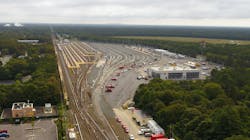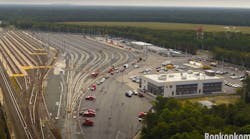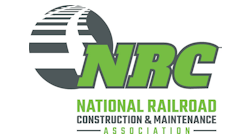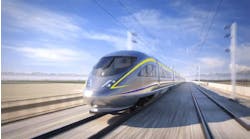In late November 2020, Metropolitan Transportation Authority (MTA) Construction & Development and the Long Island Rail Road (LIRR) announced the completion of the LIRR New Mid-Suffolk Electric Yard. The yard project is part of a larger program to modernize LIRR and was required to meet future capacity needs following the planned December 2022 opening of the mega East Side Access project, when LIRR Main Line service begins into Grand Central Terminal.
Back in 2015, at a press conference to kick off the environmental process for the yard project, then-LIRR President Patrick Nowakowski called the yard a hub for the LIRR, noting it is where the railroad’s electrification ends and diesel service begins. He also called the facility a key to the railroad’s service to Suffolk County, New York.
While the New Mid-Suffolk Electric Yard holds a vital role for current and future LIRR Main Line capacity and service reliability, the construction and expansion of the yard is a worthy tale to tell. The yard project nearly doubled the number of storage tracks that will support an almost 50 percent increase in service. Additionally, the project saw the construction of a new 32,000-square-foot employee facility.
President of MTA Construction & Development Janno Lieber said the project contributes to a more flexible and reliable railroad while LIRR President Phil Eng said the facility “is an example of how [the] LIRR is a driver of long-term economic sustainability and growth.”
The project was included in MTA’s 2010-2014 Capital Plan and saw a $108-million design-build contract awarded to Railroad Construction Company, Inc. (RCC), in December 2017, with heavy construction starting in March 2018.
The Build
The New Mid-Suffolk Electric Yard, formerly known as Ronkonkoma Yard, is situated east of the LIRR Ronkonkoma Train Station and north of Long Island MacArthur Airport. The train yard prior to construction was 100 percent utilized for morning and evening peak services. It included an employee facility, 12 storage tracks that could each hold a 12-car train consist, provided interior car cleaning and servicing, as well as mandatory Federal Railroad Administration inspections.
The expanded yard includes an additional 11 new storage tracks, each long enough to accommodate a 12-car train consist, a new employee facility, new AC and DC substations and new supporting infrastructure, all scheduled to be constructed while the yard continued its 24-hour, seven-days-a-week operations.
To accomplish this, the project was divided into two phases to preserve existing yard operations. The first phase consisted of 40,000-cubic yards of excavation, sanitary and drainage systems, construction of the new employee facility, AC Substation and supporting utilities. Phase 2 included the demolition of the existing employee facility, construction of the new lead and storage tracks, as well as supporting facilities such as utility sheds, switch tender/drill crew sheds, hazmat and material storage buildings and a new guard booth.
Split across both phases of the project, RCC also created extensive electrical underground ductbank systems to support the construction of two new AC power and DC traction power electrical substations, yard lighting, communication and security systems, 3,000 linear feet of water and fire mains, new gas service, retaining walls, new service roads and walkways.
The yard is a hub for both operational and maintenance employees and the new 32,000-square-foot, two-story, ADA-compliant Employee Welfare Facility is double the size of the previous one. The employee facility, like the yard, remains open and operational 24/7 and includes men’s and women’s locker rooms, offices (the Yard Master’s office offers a view of the entire yard), seminar rooms, training offices and a break room. Once employees were relocated, demolition on the old facility began.
With the former employee facility removed, RCC began work to install 11 new storage tracks and lead track off of LIRR’s main line which consisted of 14,000 linear feet of track and 13,000 linear feet of third rail. More than 20 12-car trains are capable of being stored in the yard on nights and weekends. Critical work such as FRA inspections, maintenance and cleaning efforts will also be performed in the expanded yard. RCC Project Manager Frank Spinozza, P.E., notes constant communication and coordination between RCC, the designer of record, HNTB, and the owner, LIRR, was paramount to ensuring success within a scope of work that spread broadly across many disciplines.
“Holding constructability review meetings for each design package at each design level and subsequent comment resolution discussions was important in ensuring the drawings and specifications met the project requirements,” said Spinozza. “Continuously updating our [Critical Path Method] schedule, modifying sequences of operations as necessary and communicating with our subcontractors and vendors was important on the construction end, as well.”
Another challenge was how to grant access to yard personnel while construction work was underway without disrupting the yard’s critical operations. RCC accomplished this through the installation of a regularly maintained temporary walkway across the work zone for LIRR pedestrian and vehicle access. Vehicle access was provided by flooding the new track with compacted ballast and a pedestrian walkway was established using a series of wood planks with non-slip rubber mats. RCC explains that as the schedule progressed, the temporary walkway was removed and reinstalled multiple times to accommodate the work.
RCC says the design/build nature of the project created challenges not typically experienced with a design-bid-build contract. Spinozza explains the project was awarded to RCC based on 30 percent design drawings, preliminary specifications, along with user and project requirements provided by the LIRR. RCC was then responsible to complete the design and construction of the project using these documents.
“In order to ensure that the final design drawings, specifications and end product fully incorporated these requirements, it was challenging, but essential to hold numerous constructability review meetings at both the design level and throughout the construction of the project,” said Spinozza.
He continued by saying the design and construction ran nearly parallel, with construction progressing as the design for each respective discipline advanced to maintain the project schedule. Spinozza says it was crucial for the team to acknowledge each edit and construct accordingly.
Spinozza added, “Quality control of the latest documents was paramount to ensure the correct drawings were being used by the field for construction.”
Never Losing Sight of Safety
The railroad environment can be unforgiving and staying engaged through active safety efforts is critical to any project’s success.
RCC utilized task specific Job Hazard Analysis with each crew at the beginning of each shift and held weekly toolbox talks, which covered an array of construction topics to keep co-workers’ focused on safety.
As explained earlier, the temporary vehicle/pedestrian access moved throughout the construction of the project. Prior to any changes to LIRR’s access, details of the work required, the safety procedures that would be implemented, and drawings to identify Maintenance and Protection of Traffic and access points were submitted to the LIRR for review.
“LIRR personnel would then review and share their concerns through the submittal process, as well as site walkthroughs with the relevant LIRR departments,” said Spinozza. “We would then modify our plans accordingly and implement the plan to ensure safety was covered on all fronts.”
What wasn’t anticipated – what couldn’t be fathomed at the start of the construction project – was the spread and impact of COVID-19.
“The COVID-19 situation in the United States, specifically New York City and surrounding suburbs where the new Mid-Suffolk Rail Yard is located, escalated in March of 2020, which was after we had completed construction of the new employee facility and our focus was constructing the rail yard,” said Spinozza. “As it came to be with the virus, working within an enclosed space presents a different set of challenges than working outside. So, with a majority of our work being outside, we had the ability to implement social distancing without adjusting the schedule or make any major changes to our work plan.”
RCC did implement additional safety measures by increasing the number of bathroom facilities and hand washing stations, providing additional cleaning supplies in shared spaces, such as equipment cabs and offices, daily meetings transitioned to a virtual platform to limit the number of on-site office personnel and RCC enforced companywide protocols that it says met or exceeded guidelines provided by the Centers for Disease Control and Prevention.
RCC did not experience a work shut down or any workforce issues related to the pandemic. While Spinozza acknowledged there were supply chain issues, he explains that the RCC Team “adjusted and worked through these issues without impacting the project schedule.”
He added, “Despite the many hurdles presented by the pandemic, RCC was very fortunate to continue construction safely on the New Mid-Suffolk Electric Yard regardless of unforeseen shutdowns and restrictions.”
Late last year, RCC’s work on the LIRR New Mid-Suffolk Electric Yard was selected by the National Railroad Construction & Maintenance Association as its 2020 Large Project of the Year. The award goes to a rail construction project that not only demonstrates overcoming challenges of that project, but demonstrates a dedication to safety. RCC completed the project with zero recordable/lost-time incidents.
A letter from LIRR Senior Project Manager Steven J. Schneider included in the award submission said RCC’s work deserved recognition and surpassed expectations.
“The last year has presented a number of obstacles no one could have predicted. The RCC team maintained a constant presence on the project site to uphold the schedule and keep construction moving forward … Pre- and post-COVID-19, the number of safety precautions that were implemented and enforced is to be commended. The quality of management surpassed our expectations,” wrote Schneider.
As Spinozza reflects on the completed project, he notes there isn’t an element that could be identified as “most challenging.”
“Each day [was] different with a new set of challenges that created an interesting yet demanding environment. As a design/build project progresses through each phase, the focus shifts from planning to construction and every detail is put to the test. When planning is done properly, materials and equipment are readily available, and the correct manpower is attributed to the task at hand; the work is performed correctly and safely, ultimately resulting in a quality project the company is proud to represent.”
By the Numbers
• 14,000 linear feet of track installed
•13,000 linear feet of third rail
• 3,000 linear feet of water and fire mains and new gas service lines installed
• 40,000 cubic yards excavated
• 2 new substations
• 0 recordable/loss time incidents
• Construction Award: NRC 2020 Large Project of the Year
Companies involved with LIRR Mid-Suffolk Train Storage Yard Project
RCC served as the general contractor with HNTB Corporation subcontracted to perform design. The project involved a host of other companies including major subcontractors:
- Century Group Inc. – Supplied Grade Crossing Panels and deflector shields
- Cleveland Track Materials (part of Progress Rail) – Supplied #8 and #10 Turnouts, Double Slip Switch, Diamond Crossing and Derail Switch
- Rocla Concrete Tie, Inc. (part of Vossloh) – Supplied Concrete Ties
- American Rail Marketing LLC – Supplied 136RE Running Rail
- G&B Specialties, Inc. – Supplied Switch Stands
- Selco Manufacturing Corp. – Supplied Third Rail Materials (Fiberglass Extension Channels, Protection Board, Protection Board Brackets, Insulators)
- Transtech – Supplied Third Rail (Conductor Rail), Splice Bars and End Approaches
- Holland L.P. – Performed Flash-Butt Welding
- Orgo-Thermit, Inc. - Supplied Thermite Weld Kits
- Eldor Contracting Corporation – Supplied and Installed the DC Substation, Conduit, Cabling/Power for Third Rail

Mischa Wanek-Libman | Group Editorial Director
Mischa Wanek-Libman is director of communications with Transdev North America. She has more than 20 years of experience working in the transportation industry covering construction projects, engineering challenges, transit and rail operations and best practices.
Wanek-Libman has held top editorial positions at freight rail and public transportation business-to-business publications including as editor-in-chief and editorial director of Mass Transit from 2018-2024. She has been recognized for editorial excellence through her individual work, as well as for collaborative content.
She is an active member of the American Public Transportation Association's Marketing and Communications Committee and served 14 years as a Board Observer on the National Railroad Construction and Maintenance Association (NRC) Board of Directors.
She is a graduate of Drake University in Des Moines, Iowa, where she earned a Bachelor of Arts degree in Journalism and Mass Communication.




